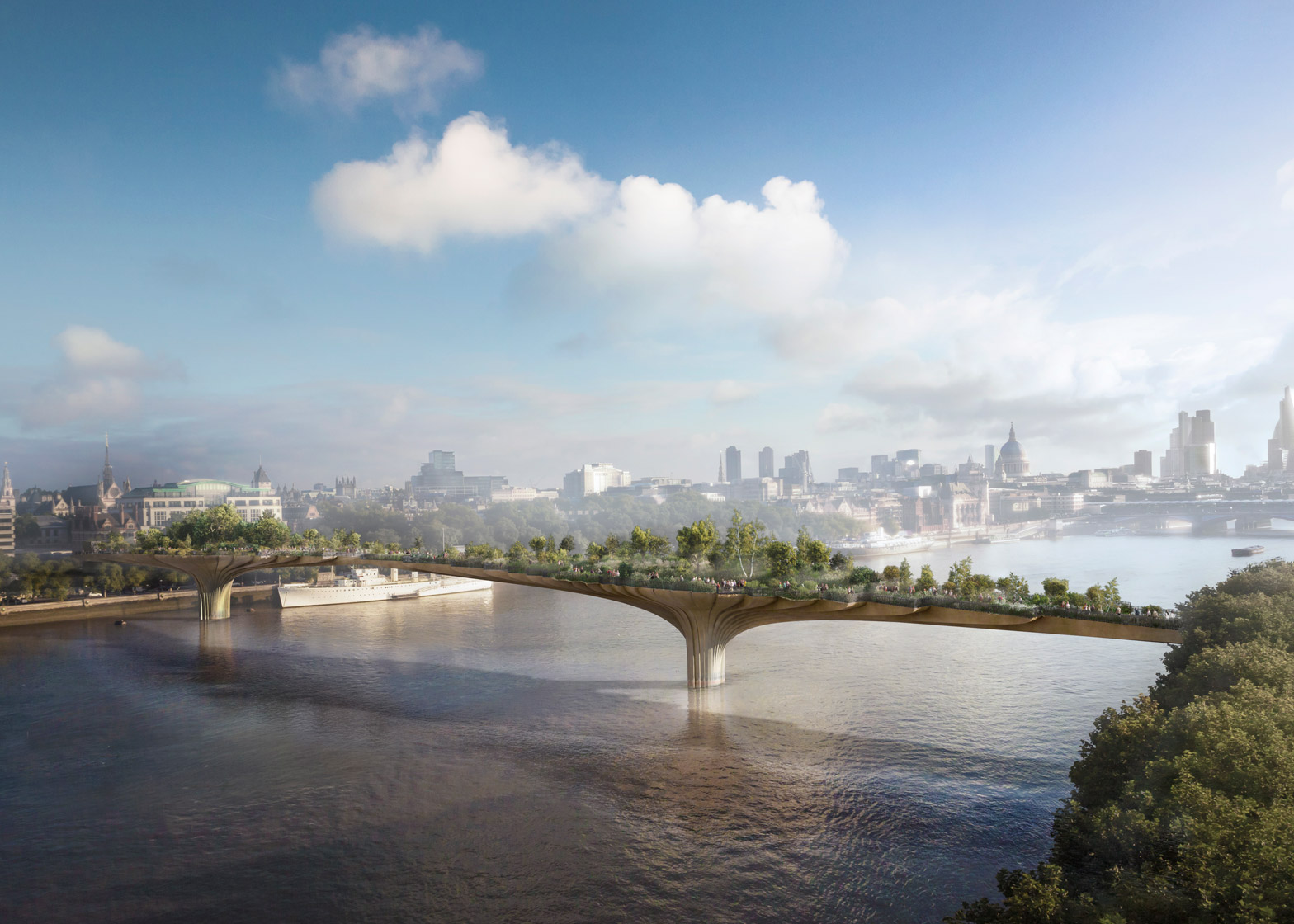Thomas Heatherwick's Garden Bridge has moved one step closer to reality with the appointment of a building contractor, despite calls for the project to be halted from a number of key figures.
Construction firms Bouygues Travaux Publics and Cimolai has been jointly selected to build the plant-covered London bridge across the River Thames – designed by Heatherwick after being conceived by British actress Joanna Lumley.
The appointment is in line with a strict timescale, which requires the structure to complete in late 2018 to avoid clashing with the construction of a major new sewer. Building work is now scheduled to start this summer.
This is in spite of the project being called into question by several important individuals in recent months over concerns around funding sources and claims the procurement process was unfairly biased towards Heatherwick.
Billed as a "beautiful new garden floating above the River Thames", the 367-metre-long Garden Bridge is proposed across the Thames between the South Bank and Temple.
It is expected to cost £175 million, with £115 million from private donations and £60 million of public money already committed. Critics have suggested that taxpayers will end up paying for the remaining £30 million.
An investigation by UK magazine The Architect's Journal found that Heatherwick was present for at least five meetings with London's mayor Boris Johnson or deputy mayors prior to the contest. The AJ also claimed that a manager for government body Transport for London (TfL) had reported irregularities in the design competition.
"It's now abundantly clear that the design competition that Transport for London held in early 2013 was nothing of the sort," AJ deputy editor Will Hurst told Dezeen.
"Every scrap of evidence that has emerged suggests that mayor Boris Johnson – who is also the chair of TfL – had already decided on designer Thomas Heatherwick because of prior lobbying by Garden Bridge champion Joanna Lumley," he added. "It is an alarming thought that a major design contest, especially one funded by the public purse, could be so manipulated and distorted by political pressure."
Jane Duncan, president of the Royal Institute of British Architects, is among those who have voiced concerns over the project.
She said she was "extremely concerned" about the fairness of the original design competition, which resulted in Heatherwick being chosen ahead of established bridge designers Wilkinson Eyre and Marks Barfield.
"Given the high-profile nature of this project, the amount of public money at stake and the seriousness of the allegations, we would urge that the project is put on hold and the whole procurement process is then opened up to detailed scrutiny," she said.
Boris Johnson has continued to publicly back the project, and has accused critics from the architecture world of being jealous of Heatherwick.
The London-based designer is not a qualified architect but his studio has a large portfolio of building projects like Britain's 2010 Shanghai Expo pavilion and Google's new HQ, as well as designs including the 2012 Olympic Cauldron.
A number of local politicians have attempted to block the Garden Bridge, including Vauxhall MP Kate Hoey and three councillors from the London Borough of Lambeth, even though planning permission was granted by both local authorities in late 2014.
Along with two Greater London Authority members, they have reportedly appealed to Coin Street Community Builders – the leaseholders of the land where the bridge will meet the South Bank – to resist the project.
Lambeth granted permission for the bridge on the grounds that 46 criteria would be met, covering everything from the construction timetable to how the structure will be managed.
One of these conditions stipulated that large groups will need to apply in advance for permission to cross – a move that has provoked criticism from the public.
The Garden Bridge Trust remains positive, claiming that 80 per cent of Lambeth's conditions have already been met and approved.
"The Garden Bridge is a reality," said Mervyn Davies, the chairman of the non-profit organisation. "We are on course with our fundraising targets, we are meeting the requirements of our planning conditions."
"We have huge public support for the project and we look forward to working with Bouygues TP and Cimolai and all our partners to make this a special place to be enjoyed by Londoners and visitors in the heart of the city for years to come," he added.
Heatherwick first unveiled his design for the bridge in 2013. He claimed the project would allow Londoners to rediscover the "amazing piece of nature" that is the River Thames.
"There is now an opportunity to connect London together better, to give Londoners a huge improvement in the quality of pedestrian river crossing in this area, to allow us all to get closer to the river and at the same time to stimulate new regeneration possibilities at both ends where it lands," he said.
Lumley said the bridge would be "sensational in every way: a place with no noise or traffic where the only sounds will be birdsong and bees buzzing and the wind in the trees, and below the steady rush of water".
Renderings are courtesy of Arup.

